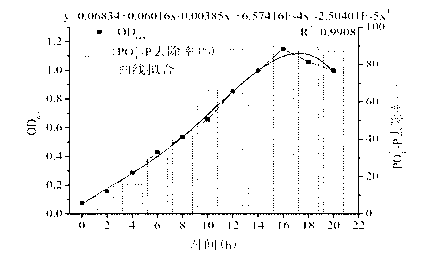Denitrifying phosphorus removal bacteria bacillus cereus H-hrb01 and screening method and application
A technology of denitrifying phosphorus-accumulating bacteria and Bacillus cereus, which is applied in chemical instruments and methods, biochemical equipment and methods, and methods based on microorganisms, can solve the problems of limited practical application research and single strains, and achieve strong The effect of phosphorus capacity on denitrifying bacteria
- Summary
- Abstract
- Description
- Claims
- Application Information
AI Technical Summary
Benefits of technology
Problems solved by technology
Method used
Image
Examples
specific Embodiment approach 1
[0022] Specific implementation mode 1: The activated sludge at the end of the anoxic section of a certain period when the SBR reactor is running stably is used as the separation sludge. Make a bacterial suspension from the activated sludge and add it to the denitrification medium. After the medium is solidified, invert the culture dish and incubate it in a constant temperature incubator at 30°C for 2 to 3 days. Select typical colonies with different shapes and clear colonies. , mark and pick a single colony on the plate medium for three-section line separation, repeat 3 to 4 times to a single colony with the same colony characteristics, and finally pick a single colony and transfer it to the prepared test tube slant for future use. All manipulations were performed under sterile conditions. The isolated strains were tested for phosphorus uptake in phosphorus-rich medium, and nitrate reduction gas production test, heterochromatic particle staining (methylene blue staining method...
specific Embodiment approach 2
[0027] By amplifying the 16S rDNA of the strain, the 16S rDNA sequence with a length of 1518 bp was obtained. The bacterial general primers BA101F 5'-TGGCGGACGGGTGAGTAA-3' and BA534R 5'-ATTACCGCGGCTGCTGCTGCTGG-3' were used as PCR primers. The amplification reaction was performed with a PCR instrument (GeneAmp, PCR System 9700). The amplification reaction was performed with a PCR instrument (GeneAmp, PCR System 9700). PCR reaction system (25 μL): 2.5 μL 10×PCR Buffer, 2 μL dNTPs (concentration: 2.5 mmol / L), 0.5 μL each of the two primers, 0.5 μL DNA template, 0.5 μL r Taq DNA polymerase (5U / μL), sterile deionized water 18.5μL. Negative samples were set as a reference in each PCR reaction, that is, DNA templates were replaced with sterile ultrapure water. PCR amplification program: The PCR amplification program for the full sequence of 16S rRNA is: 95°C pre-denaturation for 5 minutes, 94°C for 1 minute, 58°C for 30 seconds, 72°C for 3 minutes, a total of 30 cycles, and fina...
specific Embodiment approach 3
[0054] Preparation of strains Bacillus cereus Resting cells of H-hrb01: the cultured strain Bacillus cereus H-hrb01 was centrifuged at 8000 r / min at 4°C for 10 min, washed 3 times with phosphate buffer, and the pellet was resuspended with the same buffer to make the concentration of resting cells 10 mg / l, and frozen at 4°C. Standby, that is, the prepared strain Bacillus cereus Resting cells of H-hrb01.
PUM
| Property | Measurement | Unit |
|---|---|---|
| Concentration | aaaaa | aaaaa |
Abstract
Description
Claims
Application Information
 Login to View More
Login to View More - R&D
- Intellectual Property
- Life Sciences
- Materials
- Tech Scout
- Unparalleled Data Quality
- Higher Quality Content
- 60% Fewer Hallucinations
Browse by: Latest US Patents, China's latest patents, Technical Efficacy Thesaurus, Application Domain, Technology Topic, Popular Technical Reports.
© 2025 PatSnap. All rights reserved.Legal|Privacy policy|Modern Slavery Act Transparency Statement|Sitemap|About US| Contact US: help@patsnap.com



